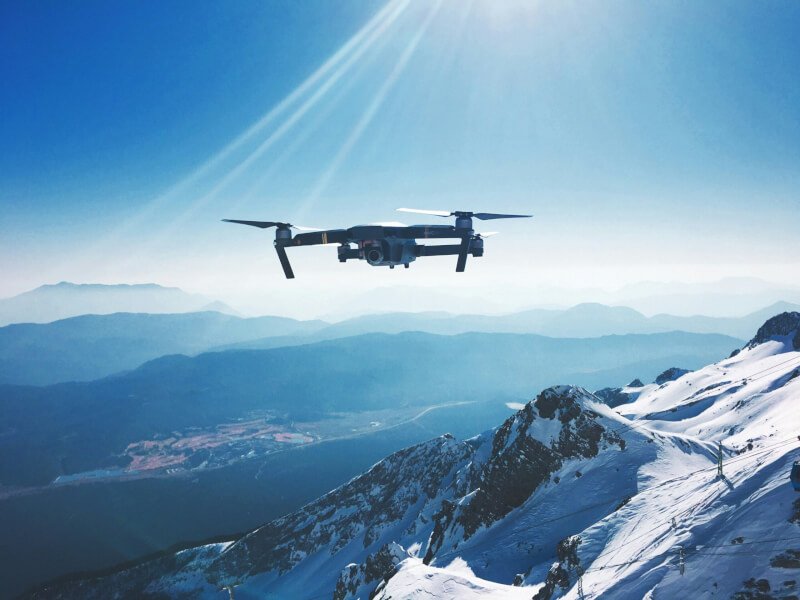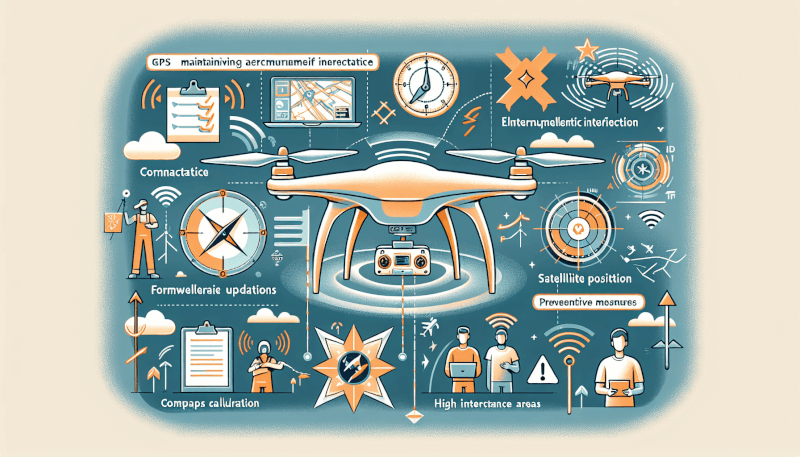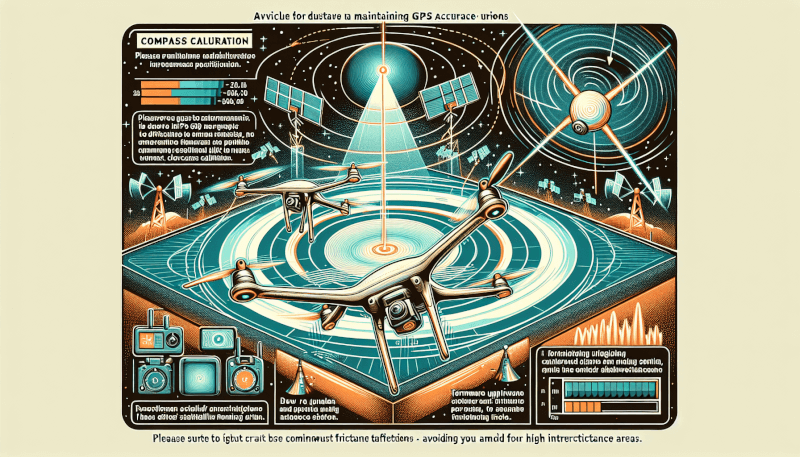If you’re an avid drone enthusiast, you know the importance of GPS accuracy. The last thing you want is for your drone to lose its signal and crash into trees or buildings. In this article, you will learn some essential tips and tricks to ensure that your drone’s GPS remains accurate and reliable. From calibrating your compass to understanding the impact of environmental factors, we’ve got you covered. So sit back, relax, and let’s dive into the world of maintaining your drone’s GPS accuracy.
Importance of GPS Accuracy for Drones
Drone technology has revolutionized various industries, from aerial photography to delivery services. However, one crucial aspect that determines the effectiveness and safety of drone operations is GPS accuracy. GPS (Global Positioning System) plays a vital role in guiding drones and providing precise location information. In this article, we will explore the significance of GPS accuracy for drones, factors that can affect it, pre-flight checks to ensure accuracy, measures to optimize accuracy during flight, post-flight practices, and troubleshooting techniques to mitigate GPS accuracy issues.
The Role of GPS in Drone Operations
GPS plays a central role in drone operations by providing crucial information such as location, altitude, and movement data. It serves as a guidance system, allowing drones to navigate accurately, maintain stable flight paths, and execute predetermined missions effectively. Without accurate GPS data, drones may struggle to maintain position and stability, posing risks to both the drone itself and its surroundings. Therefore, ensuring GPS accuracy is essential for safe and reliable drone operations.

Benefits of Maintaining GPS Accuracy
Maintaining GPS accuracy offers several benefits for drone operators. Firstly, it enhances the overall flight experience by providing precise location information, allowing for smoother navigation control, and preventing unintentional deviations. Secondly, accurate GPS data enables drones to perform complex missions such as surveying, mapping, and search and rescue operations with higher efficiency and precision. Furthermore, GPS accuracy contributes to improved safety and reduces the risk of accidents or collisions. By accurately determining the drone’s position, operators can avoid potential obstacles and maintain a safe distance from restricted areas. Overall, maintaining GPS accuracy ensures optimal performance, a better user experience, and increased safety in drone operations.
Factors Affecting GPS Accuracy
Several factors can affect the accuracy of the GPS signals received by drones. Understanding these factors can help drone operators identify potential issues and take appropriate measures to mitigate them.
Satellite Availability and Positioning
GPS accuracy heavily relies on satellite availability and their positions relative to the drone’s location. Satellites in poor orbital positions or under suboptimal conditions can result in reduced accuracy or even signal loss. In urban areas with skyscrapers or dense tree canopies, tall structures and vegetation can obstruct the line of sight between the drone and the satellites, further compromising GPS accuracy.
Signal Interference and Obstructions
Signal interference from other electronic devices, buildings, or natural obstacles can disrupt GPS signals and decrease accuracy. Electronic devices, such as smartphones or radios, can emit electromagnetic waves that interfere with GPS signals. Tall buildings, cliffs, or mountainous terrains can cause signal blockages or reflections, leading to inaccurate positioning.
Weather Conditions and Atmospheric Interference
Weather conditions, such as heavy rain, snow, fog, or storms, can affect GPS performance. Changes in the atmosphere due to atmospheric disturbances, solar flares, or ionospheric variations can introduce errors into GPS signals, leading to reduced accuracy.
Drone Hardware and Software Limitations
The accuracy of GPS data can also be influenced by the drone’s hardware and software limitations. Factors such as the quality of the GPS module, the processing capabilities of the onboard flight controller, and the accuracy of the drone’s compass calibration can all impact GPS accuracy. It is crucial to choose reliable and well-calibrated drones with advanced GPS features for optimal performance.

Pre-flight Checks for GPS Accuracy
To ensure optimal GPS accuracy before a drone flight, it is essential to perform a series of pre-flight checks. These checks help identify any potential issues and allow operators to take corrective actions before taking off.
Update Firmware and Software
Regularly updating the firmware and software of both the drone and its remote control unit is crucial to maintaining GPS accuracy. Manufacturers often release updates that contain bug fixes, performance enhancements, and improvements in GPS functionality. By staying up to date with the latest software versions, operators can ensure optimal GPS performance.
Check for Any Hardware Issues
Thoroughly inspecting the drone and its hardware components before each flight is essential to detect any potential issues that could affect GPS accuracy. This includes checking for loose connections, damaged or improperly installed GPS modules, and any signs of wear and tear. Addressing these issues before flying can prevent GPS-related problems during flight.
Verify GPS Signal Strength
Checking the GPS signal strength is a vital pre-flight step to ensure optimal accuracy. Most drones display the number of satellites being tracked and the signal strength on their controller or mobile app. Operators should ensure that an adequate number of satellites are being tracked and that the signal strength is strong enough for reliable positioning. If the signal strength is weak, finding an alternative flying location might be necessary.
Calibrate Compass and GPS
Calibrating the compass and GPS before each flight is crucial for accurate positioning. Compass calibration involves rotating the drone in a specific pattern to establish a reference point for navigation. GPS calibration ensures that the drone understands its current location accurately. Following the manufacturer’s instructions for compass and GPS calibration is important for maintaining GPS accuracy.
Confirm Home Point and Return-to-Home Settings
Verifying the home point and return-to-home settings is essential to ensure the drone can accurately return to its takeoff location if needed. Operators should establish a secure home point before each flight and check that the return-to-home function is adequately configured. A misconfigured home point or return-to-home setting can result in the drone landing or returning to the wrong location.
Perform a Test Flight before Important Operations
Before undertaking critical missions or operations that require GPS accuracy, it is advisable to perform a test flight in a controlled environment. This allows operators to verify the drone’s GPS functionality, assess signal strength and accuracy, and identify any potential issues or limitations. Conducting a test flight ensures that the drone is ready for the task at hand and minimizes the risk of encountering GPS-related problems during critical operations.
Optimizing GPS Accuracy During Flight
While pre-flight checks help ensure initial GPS accuracy, maintaining optimal accuracy during flight is equally important. Here are some practices that can enhance GPS accuracy while flying a drone:
Choose a Suitable Flying Location
Selecting a suitable flying location can significantly impact GPS accuracy. Open areas with minimal signal interference from tall structures or dense vegetation provide better GPS signal reception. Flying away from areas with strong electromagnetic interference, such as power lines or radio towers, can also improve GPS accuracy.
Avoid Areas with High Signal Interference
To preserve GPS accuracy, it is essential to avoid areas with high signal interference. Locations near airports, military installations, or crowded urban environments can have high levels of electromagnetic interference that disrupt GPS signals. By steering clear of these areas, operators can maintain a more reliable GPS connection.
Maintain Line of Sight with the Drone
Maintaining a clear line of sight between the drone and the operator can improve GPS accuracy. The operator’s position and visibility of the drone’s orientation can impact signal reception. Avoid flying behind obstacles or out of the operator’s line of sight to ensure a stable GPS connection.
Use GPS Assistance Features
Many drones offer GPS assistance features that can further enhance accuracy. These features include GPS-assisted hover, GPS waypoint navigation, and follow-me functions. Leveraging these features can improve drone stability and positioning accuracy, especially in challenging environments or during complex missions.
Monitor GPS Signal Strength During Flight
Continuously monitoring the GPS signal strength during flight is crucial to identifying potential issues. If the signal strength drops significantly or remains weak for an extended period, it is advisable to bring the drone back to a safe location to avoid GPS-related problems or loss of control.
Utilize Signal Amplification Techniques
If faced with weak GPS signals or areas with poor signal reception, operators can utilize signal amplification techniques to boost accuracy. Attachable GPS modules or antennas can enhance signal reception and improve GPS accuracy, especially in challenging environments. Investing in these external accessories can significantly enhance the reliability of GPS positioning.

Post-flight Practices for GPS Accuracy
Once the drone has completed its flight, it is essential to perform post-flight practices to ensure continued GPS accuracy. These practices help maintain the drone’s overall performance and identify any issues that may have arisen during the flight.
Inspect and Clean Drone Components
Inspecting the drone and its components after each flight is crucial to identify any damage, loose connections, or signs of wear. Cleaning the drone, especially the GPS module and antennas, helps remove dirt, dust, or debris that may obstruct GPS reception. Regular maintenance and cleaning promote optimal GPS accuracy and extend the lifespan of the drone.
Analyze Flight Logs and GPS Data
Analyzing flight logs and GPS data provides valuable insights into the drone’s performance and can help identify any irregularities or issues affecting GPS accuracy. Flight logging software or apps can provide detailed reports on GPS-related metrics, such as signal strength, tracking accuracy, and altitude fluctuations. By reviewing this data, operators can address any identified GPS accuracy issues promptly.
Update Firmware and Software as Necessary
Just as pre-flight checks involve updating firmware and software, post-flight practices should incorporate the same step. Manufacturers regularly release updates that address bugs, optimize performance, and improve GPS accuracy. Staying updated with the latest firmware and software versions ensures that the drone maintains optimal GPS accuracy over time.
Address Any Reported GPS Issues
If the drone’s operator or users identify any reported GPS issues during or after a flight, addressing these issues promptly is crucial. Consulting the drone manufacturer’s support resources or reaching out to their technical support team can provide guidance on troubleshooting steps or potential solutions. By proactively addressing reported GPS issues, operators can prevent recurring problems and maintain optimal accuracy.
Mitigating GPS Accuracy Issues
Despite taking preventive measures, GPS accuracy issues may still surface. In such cases, operators can employ additional measures to mitigate the issues and enhance accuracy.
Ensuring Proper Satellite Connectivity
Ensuring proper satellite connectivity is essential for maintaining GPS accuracy. Operators should verify that their GPS equipment is receiving signals from an adequate number of satellites. Adjusting the drone’s position or relocating to an area with better satellite visibility can help improve connectivity and accuracy.
Using Ground Station Software for Enhanced Control
Ground station software provides enhanced control and features that can contribute to improved GPS accuracy. These software solutions allow operators to plan and execute missions precisely, set waypoints for autonomous flights, and receive real-time telemetry data. By utilizing ground station software, operators can increase GPS accuracy and streamline drone operations.
Employing External GPS Modules or Antennas
In environments or situations where GPS accuracy is critical, employing external GPS modules or antennas can significantly enhance accuracy. These accessories provide better signal reception and stronger connections, thereby improving GPS accuracy. Investing in high-quality external GPS hardware is beneficial for drone operators who frequently operate in challenging or remote areas.
Investing in Quality Drone Hardware and Components
Investing in quality drone hardware and components is essential for maintaining GPS accuracy. Opting for reliable GPS modules, flight controllers, and antennas can significantly improve accuracy and reduce the likelihood of GPS-related issues. Choosing reputable brands and trusted suppliers ensures that the drone’s hardware and components meet the necessary standards for optimal GPS performance.

Best Practices for Extended GPS Accuracy
Ensuring extended GPS accuracy requires adopting a set of best practices that go beyond initial setup and regular maintenance. By incorporating these practices into drone operations, operators can maximize GPS accuracy and mitigate potential issues.
Regularly Update Drones and GPS Equipment
Regularly updating drones and GPS equipment is crucial for extended accuracy. Manufacturers often release firmware, software, or hardware updates that address performance issues, enhance functionality, and improve GPS accuracy. Staying up to date with these updates ensures that the drone’s GPS system remains optimized for accuracy.
Practice Proper Battery Management
Proper battery management is crucial for extended GPS accuracy. Using fully charged and well-maintained batteries ensures uninterrupted power supply to the GPS system. Low battery levels or deteriorating battery performance can affect the drone’s overall functionality, including GPS accuracy. By properly managing and maintaining batteries, operators can minimize the risk of GPS-related issues.
Stay Updated with GPS Related Guidelines and Regulations
Staying updated with GPS-related guidelines and regulations is essential for extended accuracy. Regulatory bodies and aviation authorities often update guidelines regarding drone operations and GPS usage. Complying with these guidelines ensures that operators adhere to best practices and maintain optimal GPS accuracy within the legal framework.
Use Multiple Positioning Technologies for Redundancy
Utilizing multiple positioning technologies offers redundancy and enhances GPS accuracy. By combining GPS with other technologies such as GLONASS, Beidou, or Galileo, operators can increase the number of satellites available for positioning. This redundancy minimizes the impact of signal obstruction or interference, resulting in improved overall accuracy.
Troubleshooting GPS Accuracy Problems
Despite taking preventive measures, GPS accuracy problems may still arise. In such situations, operators can follow specific troubleshooting steps to identify and address the issues.
Checking for Firmware and Software Updates
When encountering GPS accuracy problems, checking for firmware and software updates should be a priority. Manufacturers often release updates that include bug fixes or improvements related to GPS accuracy. Ensuring that the drone’s firmware and software are up to date can potentially resolve common GPS-related issues.
Resetting and Recalibrating GPS
Resetting and recalibrating the GPS system can help resolve accuracy issues caused by misconfigurations or software glitches. Following the manufacturer’s instructions for resetting and recalibrating the GPS module ensures that it is correctly configured and aligned with the drone’s flight controller.
Investigating External Influences on Signal Strength
If GPS accuracy problems persist, investigating external influences on signal strength is necessary. This involves identifying potential sources of signal interference or obstruction, such as nearby electronic devices, tall structures, or natural obstacles. By removing or avoiding these influences, operators can restore GPS accuracy.
Contacting Manufacturer or Technical Support
If all troubleshooting steps fail to address GPS accuracy problems, contacting the drone manufacturer or technical support is recommended. Manufacturers’ support resources or technical support teams can provide further guidance and assistance in resolving complex GPS-related issues. These experts possess in-depth knowledge of their products and can offer specific recommendations or solutions.

Conclusion
Maintaining GPS accuracy is paramount for successful and safe drone operations. GPS plays a crucial role in guiding drones, enabling precise navigation, and executing complex missions. By understanding the factors that affect GPS accuracy and following best practices, operators can ensure optimal drone performance, enhance safety, and maximize the effectiveness of their missions. With proactive maintenance, thorough pre-flight checks, continuous monitoring, and troubleshooting techniques, operators can consistently achieve high GPS accuracy and enjoy the benefits it brings to their drone operations.


